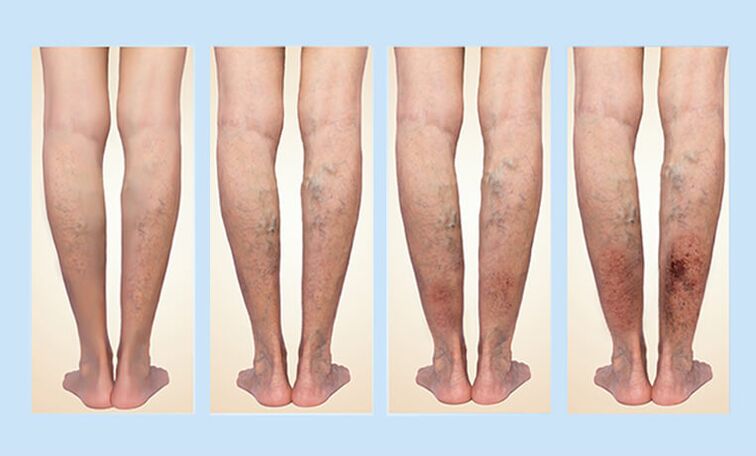There are two main methods for treating varicose veins:
- conservative,
- Operational.
The type of treatment depends on the stage of the disease.Patients with small caliber lesions in the form of vascular networks or stars of the legs, as well as with isolated local lesions of some subcutaneous veins, use non -surgical methods.
In the case of damage to large trunks of subcutaneous veins, such as a large or small subcutaneous vein, as well as their large tributaries of the thigh and lower leg, operative methods are used.
In what cases can varicose veins be treated conservatively?
Each form of varicose veins requires conservative treatment.In the event that when large subcutaneous veins are not affected, but there is only a disease of small veins of the skin in the form of vascular networks or asterisks, the conservative approach in treatment is the main one.If the disease affects larger subcutaneous veins, then conservative treatment is used in addition to surgery.
Characteristics of conservative treatment of varicose veins
Conservative treatment of varicose veins includes the following components:
- Drug therapy.
- Modification of risk factors for varicose veins.
- Wearing compression knitwear or use of elastic bandages.
- Sclerotherapy.
How to deal with the risk factors of varicose veins?
Treatment of varicose veins should begin to eliminate the risk factors of the disease:
- The fight against hypodynamia is classes of mobile sports such as swimming, bicycle, running, sports walks, skiing and more.
- Increased leg position during rest
- body weight
- Refusing static loads, heavy physical labor, frequent exposure to high temperatures - visit to the sauna, hot baths.
- Refusing to take hormonal contraceptives
- Refusing to wear high-heeled shoes (more than 5-6 cm)
Knitwear
Wearing compression knitwear or the use of elastic bandages during static loads, ie.With a long stay in the position or sitting position, it is an integral part of the treatment of varicose veins.You should choose compression linen as many patients inadequately apply an elastic bandage, pulling it at different levels or vice versa.
The compression knitwear is selected individually and has a level of compression in them by the manufacturer, the most physiological for the limb.Medical compression products (tights, socks, golf) have several compression classes.The type of compression is determined by the doctor by the results of the patient's examination and, if necessary, an instrumental examination.
- Degree I is used to prevent varicose veins,
- II - with existing signs of the disease,
- III - in cases of complex varicose veins (trophic ulcer, hyperpigmentation).
The only significant restriction on the use of compression knitwear is the difficulty in dressing it.Therefore, in order to facilitate the process of dressing, it is advisable to use a special device - an economist.If compression knitting is difficult to choose by the diameter of the limb (non -standard leg configuration) or there are other restrictions on its use - it is necessary to use elastic bandages with medium or short stretching.
Drug therapy of varicose veins
Patients suffering from varicose veins are recommended to regularly take preventive drug courses.These medicines are used for at least 1 year a year for 2-3 months.In the summer.Drug therapy does not treat the patient from already developed varicose veins, but allows you to reduce the patient's complaints about the feeling of heaviness and fatigue in the legs, their swelling.
The preparations also reduce the rate of progression of the disease, ie.The development of the more increasing development of varicose veins slows down, protecting healthy veins.The most effective treatment is to take medicines inside the form of tablets, capsules or drops.The use of medicines is less effective in the form of gels, ointments, creams or aerosols, but topical use allows you to reduce the symptoms of the disease at once during their use and are therefore often used as first aid in expressing discomfort, feeling of heaviness or fatigue in the legs.
Sclerotherapy for varicose veins
Sclerotherapy is a method of treating varicose veins, in which a special medicine is administered in the lumen of varicose veins.
After introducing it to court, its stacks stick together, leading to the "exclusion" of the vessel, ie.Carpets arise varicose veins.As a result, the blood is redirected to healthy vessels and the glued veins "exclude" from the blood.
Sclerotherapy is an outpatient procedure that can be performed without hospitalization in a hospital.After each sclerotherapy session, it is necessary to wear compression knitwear or elastic bandages for several days or weeks.In the case of major vein damage, sclerotherapy does not produce a reliable long -term result and the glued veins often reappear.In patients with damage only small venous vessels, on the contrary, this technique is very effective.Therefore, it is most commonly used for the so -called "intradermal varicose veins" when only small veins are affected by a vascular network or stars on the skin.
Complications after sclerotherapy
Complications after sclerotherapy are extremely rare (less than 1%).The main type of complications is the darkening of the skin in the field of treatment.Which can be saved for several months, and in some cases forever.Others are possible more complications - skin necrosis, etc.
